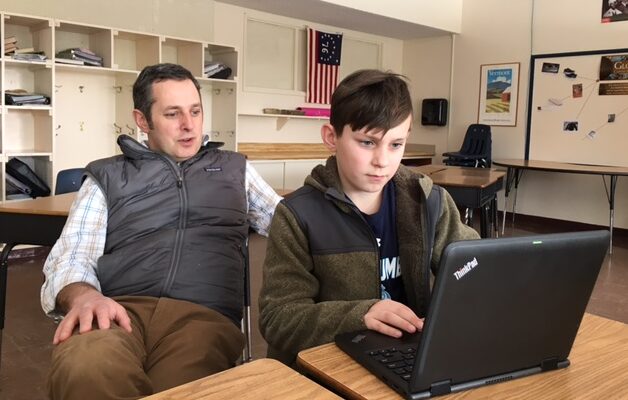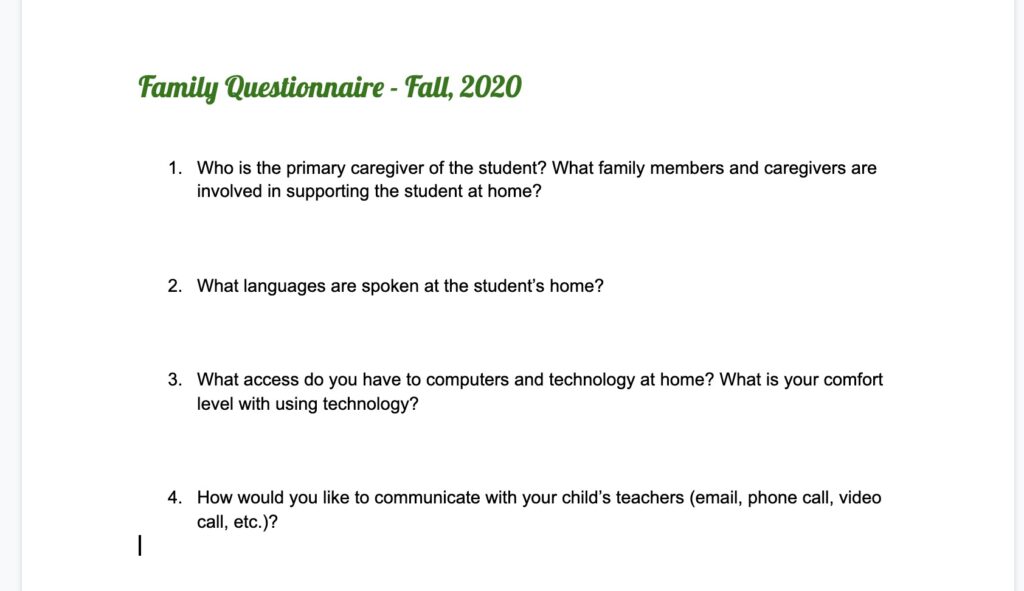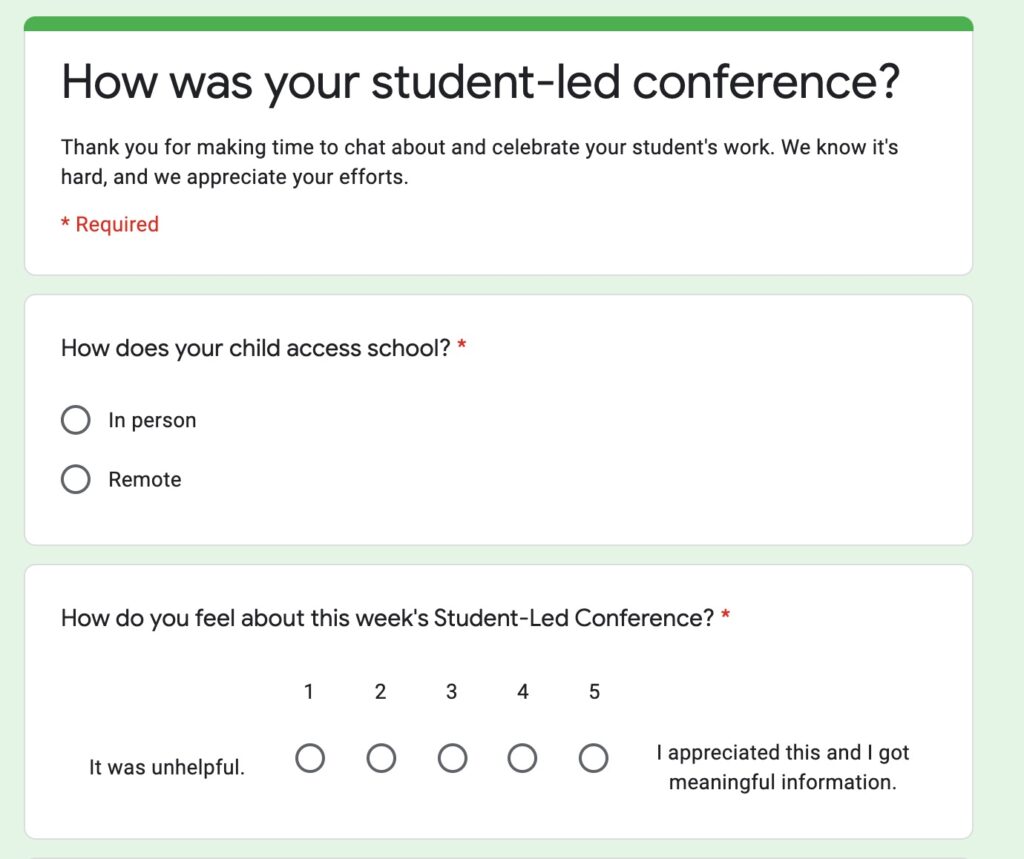Staying connected to one another during a pandemic can be hard. Like many of us, teachers and parents have faced enormous challenges keeping in touch over students this year. But we have this golden opportunity during our school student-led conferences to connect.
“I really enjoyed hearing more about my daughter’s future goals. She was nervous but presented the slide show very well. Also the PLP was very cool to learn about. I didn’t realize this was something that will be added to over the next few years!”
But why?
Educational experts agree that positive partnerships between family and school can impact student success. In Powerful Partnerships: A Teacher’s Guide to Engage Families in Student Success, Mapp, Carver and Lander identify five aspects of a family engagement event, program, or initiative that ensure its success. They are:
- Direct connection to learning.
- Builds relationships between teachers and parents, and between parents.
- Collaboration, with equal participation and input from teachers, families, and students.
- Honors families’ home languages, cultures, and experiences.
- Interactive, providing many and varied opportunities to learn together.
Now, we also know student-led conferences provide students with more agency and engagement than traditional parent-teacher conference. In fact, they can turn from student-led conferences, to student-led celebrations. Imagine that.

In our current context, nearly all schools will need to conduct their student-led conferences through one of the various video call platforms. For more help on the logistics and planning of an online student-led conference, read this vital resource. We can’t be in the same room as our students and their caregivers, but we can create the same relational experience.
Here are three tips to help you sustain the joy of a successful student-led conference during These Times.
1. Use a Pre-Conference Tool
Conferences usually happen twice a year. They take between 15 and 40 minutes. That’s not a long time! Therefore, it makes sense to reach out to families before the conference. Start the conversation. Get a sense of both their assets and needs. Kick off that feedback loop!
Before the conference, you might choose to send home a pre-conference questionnaire.
That may look like giving a paper copy to the student and asking that they serve as the liaison. In some cases, sending the questionnaire directly to parents via email might be appropriate. Do whatever you can to ensure that parents can access and participate in that questionnaire before the conference. Of course, find a logical way for them to return it to you, whether that’s by email or physical drop-box.
In that questionnaire, reach out to the student’s caregiver(s) and ask questions. Design these questions so you get to know their home environment, the strengths they bring to supporting their child as a learner, and to learn what they may need from you in collaboration during this year.
Here’s a sample questionnaire.
2. Be flexible in scheduling conferences
School hours do not accommodate most families’ work schedules. Sometimes we schedule school events during the school day, which is natural and often necessary. But we don’t have to schedule parent events during the school day. One positive outcome of the pandemic is that many of us have gotten really good at videoconferencing. And if parents need tech support with their Zoom call, there’s certainly now a kid in the house with those skills and tools.
This year, for health reasons, we cannot invite our students’ families into our school buildings. If I were an administrator, I would encourage my teaching staff to conduct conference zoom calls wherever is most convenient and comfortable. For many teachers, that is from home.
“I really appreciated being able to do it so late at night.” –Fall 2020 parent conference participant
Given that we are connecting virtually with parents outside of school hours, we should invite parents to schedule conferences flexibly around their needs. In my years as a teacher, I can remember meeting some parents at 7 am before work, and I needed to meet others at 7 pm. Those were exhausting days! But given the opportunity to conduct conferences from your homes (rock the Zoom mullet, people), we should be able to find time for all families.
3. Build in interaction & involvement
During the conference conversation, be sure to build in opportunities for parents to respond to their child’s goals or performance. In some cases, teachers utilize an informal script that reminds them to seek feedback and thoughts from the parent. Let’s say, for example, that an eighth grader (I’ll call him Henry) has just shared his personal goals with his teacher and caregiver. The teacher could then turn to the caregiver and ask any or all of the following:
- What do you think of Henry’s goals?
- What questions do you have about his goals?
- Do you agree with those goals based on what you see at home?
- What are your goals for Henry for this year?
Even better, create a space to document the parent’s thinking and feedback. If students use a digital slideshow to share and guide their conference, you could provide slides that capture their feedback and responses. See this example here.
Back in the beforetimes, I had the opportunity to interview some students at The Dorset School, in Dorset VT. They talked to me about the slideshows they’d prepared for student-led conferences, which they actually wound up recording as screencasts before the conference. Family conferences, even student-led ones, can be nerve-wracking for the student, and having the opportunity to record their presentation in advance can really help tamp those nerves down.
“My student should have practiced her part to be a bit more prepared.” –parent exit poll feedback
That said:
Y’all Are Doing Amazing. Really.
Rutland Middle School, in Rutland VT, recently completed a round of student-led conferences during this pandemic. They set out to include everyone, to make everyone feel included, supported and brought fully in to the conversation. They gave their students a slideshow assignment to prepare in advance, they gave families plenty of advance notice and a variety of early and late time-slots. And they gave parents an exit poll, so they could not just keep the feedback loop going, but use it to keep bringing families in.
It’s going to take all of us to get through this, and they know that.
But don’t take our word for it…
What does it look like when families feel genuinely included and moved by a student-led conference?
- “I loved the fact it was so interactive! Not just mechanically but also talking with ***** and my son at the same time. It was fun to watch my son present a slide show that clearly took some thought, creativity, and time.”
- “I love that the conference was child driven! It really puts ownership on the student!”
- “I wouldn’t change anything. And I appreciate all of Mrs ____’s support!”
- “Well, I thought M____’s teacher was very nice and caring.”
- “I enjoyed how my son and his teacher explained every thing about his slide show. I think that everyone is doing a great job.“
And especially in These Uncertain Times? That feels AMAZING.
Additional resources for student-led conferences:
- Successful student-led conferences
- Making pandemic student-led conferences work
- Switching to online student led conferences
- Video evidence & reflection for student-led conferences
- Who should be assessing student-led conferences?
- The student-led conference as celebration
- PLPs in Seesaw
- How to design pre-conference conversations with families
- Student-led conferences come to Leland & Gray
- How to evaluate student-led conferences
Please note: in the image accompanying this post, the two people pictured are part of the same pod, and thus don’t have to observe masking or social distancing together.





I always prefer to read quality and glad I found this thing in your post. Thank you for the comprehensive article.